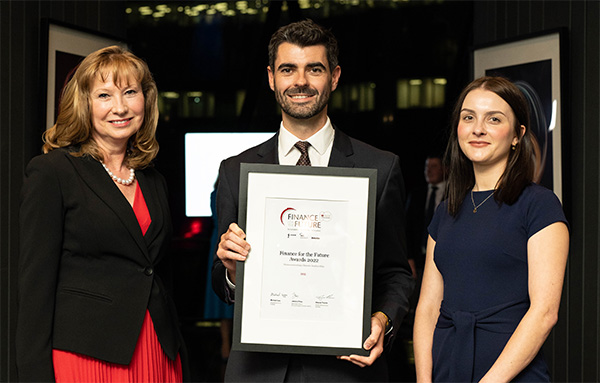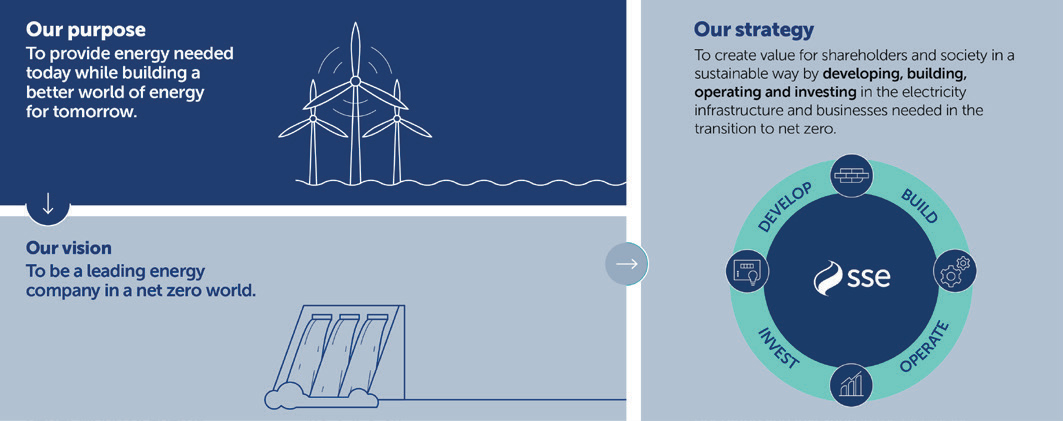What?
Electricity network company SSE has embedded net zero into its purpose, vision and strategy. Its vision is “to be a leading energy company in a net zero world”.
The company has four 2030 business goals, linked to the UN Sustainable Development Goals (SDGs):
- Cut carbon intensity by 80%
- Increase renewable energy output fivefold
- Enable low-carbon generation and demand
- Champion a fair and just energy transition
To show how it plans to achieve these goals, SSE developed its Net Zero Acceleration Programme (NZAP). The NZAP sets out £12.5 billion of planned capital investment and how this will be funded.
Shareholders formally approved SSE’s plans to become net zero by 2050 at an AGM in July 2021, and SSE published its detailed Net Zero Transition Plan in 2022. This document sets out actions and timelines for how SSE plans to reach net zero, including estimates of the impact these actions will have on scope 1, 2 and 3 greenhouse gas emissions.
To keep shareholders informed on progress against the transition plan, SSE committed to producing annual net zero transition reports. The first of these reports was released in June 2022.
SSE’s climate communications were comprehensive, leading and innovative. Their net zero transition plan and progress report, the associated acceleration programme and their focus on a just transition clearly demonstrated how they are moving from targets to action. The judges particularly commended the shareholders ‘annual say on climate’.
Why?
SSE believes that by focusing on net zero – through its 2030 goals, NZAP and Net Zero Transition Plan – it can create long-term value for both its shareholders and society. As the net zero strategy is central to its operations and planned investments, the company wanted to clearly communicate the strategy to the market.
Developing the Net Zero Transition Plan gave the company a concrete series of actions for meeting its 2030 goals and the NZAP provides the capital investment plans to deliver them. These plans have both provided a framework for internal decision making in the business and made SSE’s goals tangible and credible to shareholders.
Feedback from shareholders has been positive. Shareholders have appreciated SSE’s transparent approach in specifying how the company plans to invest its capital and how it plans to fund those investments.
We think we can create value for shareholders and society simultaneously. And how we believe we will do that is by developing, building, operating and investing in infrastructure that is part of the net zero transition.


How?
Through its stakeholder communications, SSE has made its commitment to net zero clear and how it will put this into practice:
- To select the most appropriate goals for the business, SSE did a materiality assessment of the UN SDGs. The company identified the four SDGs where it felt it could have the biggest impact: climate action (SDG 13); affordable and clean energy (SDG 7); industry, innovation and infrastructure (SDG 9); and decent work and economic growth (SDG 8). These SDGs formed the basis of SSE’s 2030 business goals.
- To achieve its 2030 goals, SSE developed plans for significant capital investment that are documented in the NZAP. Finance made sure that proposed investments met SSE’s investment criteria for return on capital and provided realistic costs. Treasury and corporate finance teams then developed a plan to fully fund the investments.
- In the Net Zero Transition Plan, SSE set out 14 actions for achieving its 2030 goals and getting to net zero by 2050. The plan documents SSE’s greenhouse gas emissions targets, what it will do to meet those targets and the challenges that it will face in doing so. Finance contributed to the planned timeframes and assessed the affordability of proposed actions. SSE sent the transition plan to its key stakeholders and held virtual events for investors to discuss the plan in detail.
- SSE committed to providing update reports each year on the Net Zero Transition Plan, covering progress against the 14 agreed actions with supporting commentary. Each year, this standalone report will be put to a vote at the AGM, giving shareholders an ‘annual say on climate’. As well as external reporting, finance produces monthly management reports, tracking progress against all programmes, including the NZAP.
- SSE set up a Powering Net Zero Pact to work more closely with strategic suppliers on sustainability, and particularly reducing carbon emissions. The pact brings together major companies in the energy industry supply chain. Together, the group aims to drive action on a range of social and environmental issues, including net zero, biodiversity and a just transition.
- The company published a just transition strategy, which lays down 20 principles for shifting away from high-carbon activities and towards net zero. The strategy focuses on the impact of activities on workers, consumers and communities. It has also published an in-depth worker transition report, as part of its work towards a just transition, which outlines 10 commitments from SSE as well as recommendations for government and industry on how to ensure a just transition for workers.
Download the case study
Want a copy of this case study? You can download a PDF version using the link below.
